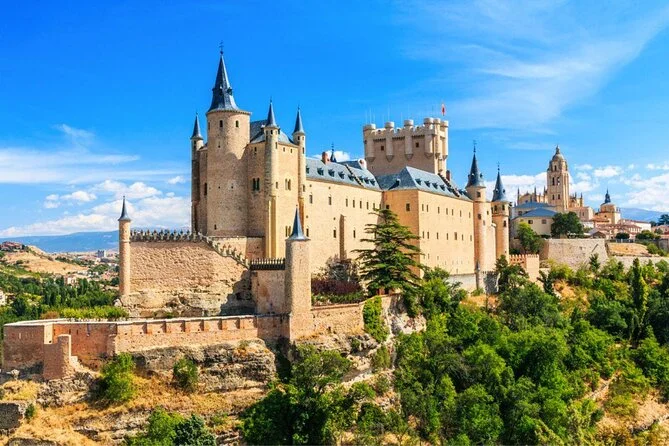
The Alcázar of Segovia is a stunning castle located in Segovia, Spain, known for its distinctive ship-like shape and rich history. Originally built as a fortress, it has served various purposes over the centuries, including a royal palace, a military academy, and a prison. The architecture showcases a blend of styles, primarily Mudejar, Gothic, and Romanesque, reflecting the diverse influences that have shaped its design. The Alcázar is surrounded by picturesque landscapes and is a UNESCO World Heritage site, attracting visitors with its impressive towers and historical significance.
Location: The Alcázar of Segovia is strategically situated in the heart of Segovia, Spain, at an elevation of approximately 1,000 meters (3,281 feet) above sea level. This elevated position not only provided a strategic advantage for defense but also offered breathtaking views of the surrounding landscape, including the nearby mountains and the city itself. The location has contributed to its historical significance, as it allowed for visibility over key routes and access to the region’s resources.
Construction Date: The original construction of the Alcázar began in the 12th century, around 1120 AD, during the reign of Alfonso VI of Castile. Initially built as a fortress, the Alcázar was constructed to serve as a royal residence and military stronghold. The choice of starting this monumental project during the medieval period reflects the socio-political dynamics of the time, as the kingdom sought to establish power and security in a region characterized by territorial conflicts and shifting alliances.
Architectural Style: The Alcázar showcases a remarkable blend of architectural styles, including Romanesque, Gothic, and Mudejar influences. This eclectic mix is evident in its intricate designs, structural elements, and decorative motifs. The Romanesque style is reflected in its robust forms and rounded arches, while the Gothic elements are apparent in the pointed arches and flying buttresses. The Mudejar style, which combines Islamic and Christian artistic traditions, is particularly visible in the ornate tile work and wooden ceilings, highlighting the cultural exchanges that occurred during Spain’s history.
Height: The highest point of the Alcázar reaches about 35 meters (115 feet), making it an impressive structure that dominates the skyline of Segovia. This height not only serves aesthetic purposes but also enhances its defensive capabilities, allowing for better surveillance of the surrounding area. The architectural design incorporates towers and battlements that further contribute to its imposing presence, making it a formidable fortress in its time.
Shape: The fortress is famously known for its distinctive ship-like shape, which is thought to resemble the bow of a ship. This unique design is not merely decorative; it also reflects the military architecture of the period, where such shapes were advantageous for defense. The ship-like silhouette has become an iconic representation of the Alcázar, symbolizing both its historical significance and its role as a royal residence.
Historical Use: Throughout its long history, the Alcázar has served multiple purposes, including that of a royal palace, military fortress, and state prison. Its versatility is a testament to its architectural resilience and adaptability to the changing needs of the monarchy and the state. As a royal residence, it housed numerous kings and queens, while its function as a military stronghold was crucial during various conflicts. The transformation into a state prison highlights the darker aspects of its history, where it was used to detain political prisoners and enemies of the crown.
UNESCO World Heritage Site: The Alcázar is part of the UNESCO World Heritage Site designation for the city of Segovia, recognized in 1985. This designation underscores its cultural and historical significance, as it is considered an outstanding example of medieval architecture and urban planning. Being included in this prestigious list not only helps in the preservation of the Alcázar but also promotes awareness and appreciation of its historical value among visitors and scholars alike.
Royal Connections: The Alcázar was one of the favorite residences of King Alfonso X of Castile, who ruled during the 13th century. Known as “Alfonso the Wise,” he was a significant figure in Spanish history, contributing to the cultural and intellectual life of the kingdom. His preference for the Alcázar reflects its importance as a royal seat and a center of power during his reign, where it hosted various courtly events and gatherings.
Towers: The Alcázar features several towers, with the most famous being the Torre de Juan II, which stands at 30 meters (98 feet). This tower is notable for its height and architectural elegance, serving both defensive and aesthetic purposes. The towers of the Alcázar not only enhance its silhouette but also symbolize the power and authority of the monarchy. They are often adorned with decorative elements that reflect the artistic styles of different periods, making them a focal point for visitors.
Interior Rooms: The Alcázar boasts over 20 rooms open to the public, including the Hall of Kings and the Throne Room. Each room is richly decorated and serves as a testament to the opulence of royal life. The Hall of Kings features portraits of the Spanish monarchs, while the Throne Room is adorned with intricate tapestries and furnishings that reflect the grandeur of the Spanish court. These interior spaces provide visitors with a glimpse into the historical significance and artistic achievements of the era. The carefully curated decorations, including ornate ceilings and elaborate chandeliers, showcase the craftsmanship of the time. Visitors can also appreciate the fusion of different architectural styles, such as Mudéjar, Gothic, and Renaissance influences, which contribute to the unique character of the Alcázar. Each room tells a story, offering insights into the lives of the royals who once inhabited this magnificent palace and the cultural heritage of Spain. Exploring these interior rooms allows guests to immerse themselves in the rich history and artistry that define the Alcázar.
Construction Material: The primary material used in the construction of the Alcázar is local granite, which was readily available in the region. This choice of material not only ensured the structural integrity of the fortress but also contributed to its distinctive appearance. The durability of granite has allowed the Alcázar to withstand the test of time, preserving its historical features and architectural details. The use of local materials reflects the resourcefulness of medieval builders and their connection to the surrounding landscape.
Restoration: The Alcázar underwent significant restoration in the early 20th century, particularly after a devastating fire in 1862 that caused extensive damage to the structure. The restoration efforts aimed to preserve the historical integrity of the fortress while also adapting it for modern use. Skilled craftsmen and architects worked meticulously to restore the original features and enhance the overall aesthetic, ensuring that the Alcázar remained a prominent symbol of Segovia’s heritage. These restoration efforts have allowed the Alcázar to continue to attract visitors and serve as a cultural landmark.
Museum: The Alcázar houses a military museum that showcases historical artifacts and exhibits related to the military history of Spain. This museum offers visitors a glimpse into the past, featuring weapons, uniforms, and various military memorabilia that highlight the role of the Alcázar as a fortress. The collection provides educational insights into the evolution of military strategy and technology over the centuries, making it a valuable resource for those interested in history and warfare.
Cloister: The Cloister of the Alcázar is noted for its beautiful Mudejar-style arches, which exemplify the intricate craftsmanship characteristic of this architectural style. The cloister serves as a serene space that contrasts with the fortress’s more imposing features, allowing visitors to appreciate the artistic details and the peaceful ambiance. The Mudejar arches, with their decorative tile work and wooden elements, reflect the cultural fusion that occurred in Spain during the medieval period, showcasing the influence of both Islamic and Christian design traditions.
Famous Events: The Alcázar was the site of the wedding of King Ferdinand II of Aragon and Queen Isabella I of Castile, a significant event in Spanish history that took place in 1469. This union marked the beginning of a powerful dynasty that would eventually unify Spain and lead to the establishment of a global empire. The marriage of Ferdinand and Isabella is often viewed as a turning point in Spanish history, and the Alcázar’s role as the venue for this momentous occasion adds to its historical significance.
Film Appearances: The Alcázar has appeared in various films, including “El Cid” (1961) and “The Last Crusade” (1989). Its striking architecture and picturesque setting make it a popular choice for filmmakers seeking to depict historical or fantastical narratives. The fortress’s cinematic appearances have contributed to its global recognition, attracting film enthusiasts and tourists alike who wish to experience the locations featured in their favorite movies.
Visitor Numbers: The Alcázar attracts over 200,000 visitors annually, making it one of the most popular tourist destinations in Spain. This influx of visitors underscores the fortress’s appeal as a historical and cultural landmark. Tourists come to explore its rich history, stunning architecture, and beautiful surroundings, contributing to the local economy and fostering interest in the preservation of cultural heritage.
Gardens: The Alcázar is surrounded by beautiful gardens, including the gardens of the “Casa de la Moneda.” These gardens provide a picturesque setting for the fortress, enhancing its aesthetic appeal and offering visitors a tranquil space to relax and enjoy the scenery. The gardens are designed with a variety of plants, pathways, and seating areas, allowing guests to appreciate the natural beauty that complements the historical architecture of the Alcázar.
Defensive Features: The fortress is equipped with various defensive features, such as a moat and thick walls, designed to protect it from potential invaders. The moat, which surrounds the Alcázar, served as an additional barrier, making it more difficult for attackers to approach the fortress. The thick walls, some reaching up to 3 meters (9.8 feet) in thickness, were constructed to withstand siege attacks and provide a secure environment for those within. These features reflect the military ingenuity of the time and the importance of fortifications in medieval architecture.
Cultural Significance: The Alcázar is an iconic symbol of Segovia and Spanish history, representing the rich cultural heritage of the region. Its architectural grandeur and historical importance have made it a focal point for both locals and tourists. The fortress not only serves as a reminder of Spain’s medieval past but also plays a vital role in contemporary cultural identity, attracting scholars, historians, and visitors interested in the interplay of history and architecture. The Alcázar’s unique design reflects the diverse influences that have shaped Spanish culture over the centuries, making it a valuable subject for academic study and a source of inspiration for artists and writers. Additionally, the site hosts various cultural events, exhibitions, and educational programs that engage the community and promote awareness of the region’s history. As a UNESCO World Heritage Site, the Alcázar also contributes to the preservation of cultural heritage, encouraging discussions about historical narratives and their relevance in today’s society. Its enduring presence continues to foster a sense of pride and connection among the people of Segovia and beyond.
Interior Decoration: The interior of the Alcázar features intricate tapestries and furniture from various historical periods, reflecting the opulence and artistic tastes of the time. Visitors can admire the detailed craftsmanship of the tapestries, which often depict historical events, allegorical themes, and scenes of daily life. The furniture, ranging from ornate chairs to elaborate tables, showcases the luxurious lifestyle of the Spanish monarchy. The combination of these decorative elements creates a rich visual experience that transports visitors back to the grandeur of royal life in medieval Spain.
Height of Walls: The outer walls of the Alcázar can reach thicknesses of up to 3 meters (9.8 feet), a testament to the fortress’s robust construction designed for defense. Such thick walls not only provided physical protection against attacks but also contributed to the building’s overall stability. The impressive height and thickness of the walls serve as a reminder of the strategic military considerations that influenced the design of the Alcázar, making it a formidable stronghold during its operational period.
Roman Influence: The site of the Alcázar was originally a Roman fort, which laid the groundwork for later constructions. This historical connection to Roman architecture is significant, as it reflects the long-standing military and strategic importance of the location. The remnants of Roman influence can still be seen in the layout and foundational elements of the Alcázar, highlighting the continuity of history in this site that has evolved through various cultural and political changes over the centuries.
Artistic Features: The Alcázar contains several notable artworks, including frescoes and carvings from different eras. These artistic features enhance the aesthetic appeal of the fortress and provide insight into the artistic styles and cultural influences that have shaped its history. The frescoes, often depicting religious or historical themes, contribute to the overall narrative of the Alcázar, while the intricate carvings showcase the skill of artisans who worked on the fortress. Together, these artworks enrich the visitor experience and underscore the Alcázar’s role as a center of cultural expression.
Accessibility: The Alcázar is accessible to visitors, including those with mobility impairments, with designated paths and facilities designed to accommodate all guests. This commitment to accessibility ensures that everyone can experience the historical and architectural significance of the fortress. The thoughtful design of pathways, ramps, and information points allows for a comfortable visit, making it possible for a diverse range of individuals to explore and appreciate the beauty and history of the Alcázar without barriers.
- What is the Alcázar of Segovia?
The Alcázar of Segovia is a historic castle located in the city of Segovia, Spain. It is one of the most iconic landmarks in the country, known for its distinctive ship-like shape and fairy-tale appearance. Originally built as a fortress, it has served various purposes throughout history, including a royal palace, military academy, and prison. - When was the Alcázar of Segovia built?
The origins of the Alcázar date back to the 12th century, during the reign of King Alfonso VI. However, it has undergone numerous renovations and expansions over the centuries, particularly in the 15th and 16th centuries, when it was transformed into a royal residence. - What architectural styles are represented in the Alcázar?
The Alcázar showcases a mix of architectural styles, including Romanesque, Gothic, and Mudejar influences. The combination of these styles reflects the various periods of construction and the cultural influences present in Spain during its history. - What can visitors see inside the Alcázar?
Visitors to the Alcázar can explore several notable areas, including:
The Throne Room: Decorated with rich tapestries and historical artifacts.
The Hall of the Kings: Featuring portraits of the Spanish monarchs.
The Tower of Juan II: Offering panoramic views of Segovia and the surrounding landscape.
The Armory: Showcasing weapons and armor from different historical periods.
- Is there an entrance fee to visit the Alcázar?
Yes, there is an entrance fee to visit the Alcázar of Segovia. The ticket prices may vary based on age, student status, and whether you choose a guided tour. It’s advisable to check the official website for the most current pricing and any available discounts. - How do I get to the Alcázar of Segovia?
The Alcázar is located in the city center of Segovia, making it easily accessible on foot from other major attractions. If you are traveling from Madrid, you can take a train or bus to Segovia, and from there, it’s a short walk to the castle. - What are the opening hours of the Alcázar?
The opening hours can vary seasonally, so it is best to check the official website for the most accurate and up-to-date information. Generally, the Alcázar is open year-round, but hours may be extended during the summer months. - Are there guided tours available?
Yes, guided tours are available for visitors who want a more in-depth understanding of the history and architecture of the Alcázar. These tours can be booked in advance and are often available in multiple languages. - Can I take photos inside the Alcázar?
Photography is generally allowed in the Alcázar, but there may be restrictions in certain areas. It’s always a good idea to check for any signage indicating whether photography is permitted. - What nearby attractions should I visit?
While visiting the Alcázar, you may also want to explore other nearby attractions such as:
The Roman Aqueduct of Segovia: A UNESCO World Heritage site.
The Segovia Cathedral: Known for its stunning Gothic architecture.
The Plaza Mayor: A lively square with shops and restaurants.
If you have any further questions or need more specific information, feel free to ask!









